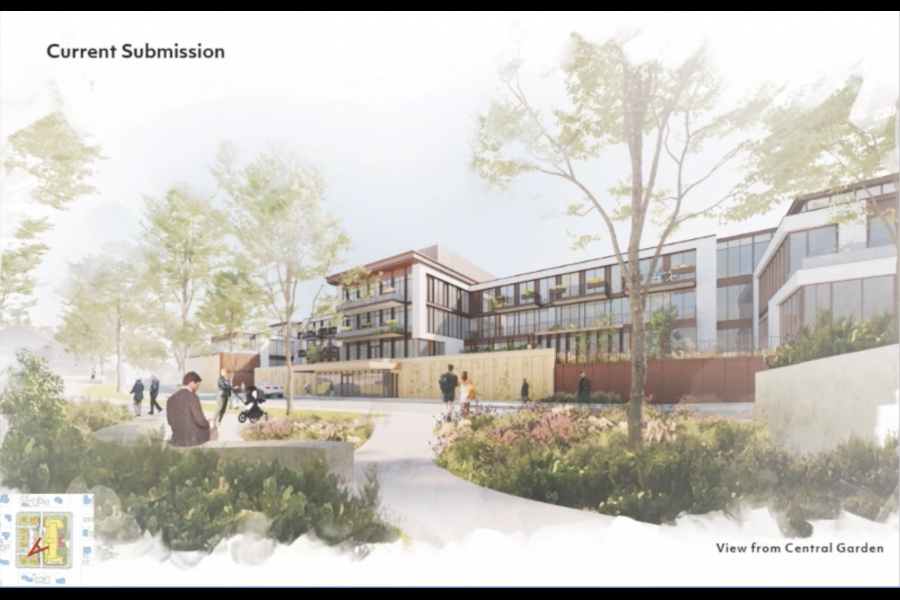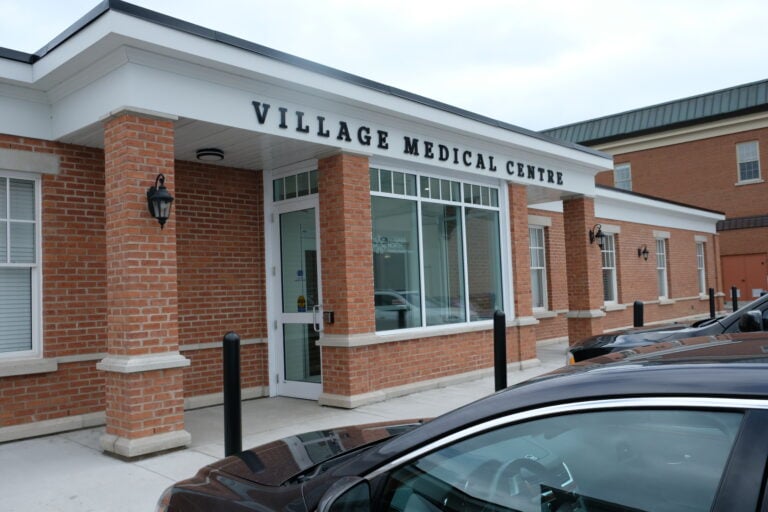Parliament Oak development faces strong opposition at open house
Niagara-on-the-Lake residents came out in force Monday against a planned apartment development on the old Parliament Oak school site, suggesting the proposal could signify the end of Old Town as it is known.
“What we’re confronting here is the very future of our town and its heritage,” 45-year NOTL resident Jim Reynolds told an online open house hosted by the town.
More than 35 residents signed up to speak out against the development during a committee of the whole meeting which lasted nearly six hours. No residents spoke in favour of the project.
The only supportive comments came from town planner Mark Iamarino, reading comments from an anonymous resident. Iamarino noted it was the only letter received in support of the project.
"The proposal contributes significantly to the sustainability, livability and opportunities in Old Town. The existing housing market is extremely exclusive and this proposal would allow the community to accommodate a new variety of individuals," Iamarino read.
"This individual also said that a three-storey building would not destroy our town."
Residents attending the open house had a very different opinion.
“What (developer Liberty Sites (3) Ltd.) is proposing is the wholesale destruction of the geographic centre of the Old Town,” Reynolds said.
“It’s as if an alien species has descended on our town with a malignancy so profound that we can only recoil in horror and dismay.”
Reynolds compared the current proposal of a 300-foot-long and 40-foot tall apartment on King Street to the burning of NOTL during the War of 1812 after being betrayed by a Canadian turncoat named Joseph Wilcox.
“What remained was a smoking ruin of foundations and chimneys,” he said.
“We now stand and face another invader but one who pretends that his actions are benign and will enhance our town,” Reynolds said of the developer.
“Nothing could be further from the truth. If this development is approved, it will stand for a century as a monument to folly, shortsightedness and greed.”
Reynolds said the future of Old Town will “live or die by this decision.”
He was far from alone in that sentiment and others expressed fears that if the apartments are approved it will open the floodgates for high-density development throughout the historic centre.
Janice Thomson, the Niagara Foundation’s president, spoke at length about her opposition to the project.
“Do you see this as a first step, in terms of the next developer coming in and using Parliament Oak as an example of being compatible?” Lord Mayor Betty Disero asked Thomson.
“On behalf of the foundation, I would say absolutely yes,” Thomson answered.
The fear of the precedent became a focal point for speakers.
“This building goes the whole block. We have nothing like it. It’s absolutely wrong,” Paul Shepherd said.
“If this calamitous development is allowed to proceed, a dangerous precedent will be set and, trust me, many more will follow,” said Alan Gordon, a nearby resident and vocal critic of the plan.
Liberty Sites is proposing to have the land rezoned as medium-density residential.
On behalf of Liberty Sites, Paul DeMelo proposed a density of roughly 22 units per acre.
Marilyn Bartlett, one of the first speakers, pointed out the definition of medium density in the town's official plan is 12 units per acre and further argued the true density of the proposed development is 27 units per acre.
Gordon said the surrounding lands have a density of 3.5 units per acre and any build should be compatible with that number.
Several residents, such as Bartlett, said they were fine with the land being developed for residential use so long as it was low density only.
DeMelo spoke to three specific areas of criticism of the development. Regarding density, he said under the official plan the land can have increased density if an analysis shows there would be minimal impact on the surrounding neighbourhood.
He addressed the building's height. At roughly 12 metres tall, the apartment would be taller than the official plan's recommended height of 11 metres.
“There’s not a prohibition against additional building height,” he argued, saying while it was taller than the official plan recommends, that plan does allow for taller buildings.
DeMelo spoke against arguments the site is not appropriate for intensification, saying the area was not considered for intensification because it was a school when intensification areas were being identified.
“In our respectful submission, had the school closed when (intensification areas) were being contemplated, this site would have met the characteristics for an appropriate infill intensification site,” he said.
Resident Joan Pruitt addressed DeMelo’s points one by one.
Regarding intensification, she said his argument is entirely hypothetical and shouldn’t be focused on.
“What we need to focus on is what is currently under our official plan and the current designation (for Parliament Oak) is not medium density,” she said.
Regarding the density, Pruitt said the argument is erroneous because the development would have a negative impact on the surrounding neighbourhood.
“I don’t think (Liberty Sites) have provided any accurate description or demonstrated anything that would say this is minimal impact,” she said.
Regarding the building's height, Pruitt agreed council has the power to allow taller buildings in Old Town.
But council could also “limit building heights to below 11 metres” in low-density residential areas, she said.
Pruitt encouraged the town to consider making the building height even less if the project moves ahead.
Several residents told council they felt the developer was disrespecting the town’s official plan.
“It seems a little bit out of line to ask the council to throw out all of the work that you’ve done (on the official plan) so that the developer can build what they would like and maximize profits,” Pruitt said.
“Submissions for this property have to be in alignment with our official plan or what is the purpose of council devoting so many hours to ensure we have an official plan that dictates the development of our town?” Bartlett read from a letter on behalf of 37-year NOTL resident Judy Pepe.
Bartlett asked council why the town should make “any amendments to the zoning bylaw or our official plan” to accommodate the developer's wants.
“Why? Why would you let this happen? Why would you step so far away from the official plan? And why would you allow something this big to happen in an established residential area?” Lyle Hall rhetorically asked councillors.
While still focused on the details of the three-storey, 300-foot-long structure, residents shared their fears that the approval of the development would be the end of Old Town as they know it.
“Don’t just get that property for the taxes it’s going to bring us, no. Think of the future,” said retired science teacher Leon Martin.
“We can save the property. We can put in something really decent and people will share that with their grandchildren and so on. Not something like this, which we can see all over Toronto and every place else.”
The proposal includes more than 140 parking spaces for cars, which some residents saw as a way to highlight the influx of vehicle traffic the development would bring.
“160 cars in one single town block,” resident Eduardo Paraffin said. “This is crazy.”
Carl Finkle shared the same view, adding his concern over the extra cars coming into the neighbourhood as a result of visitors.
He pointed out that the apartment building has 71 proposed units, whereas the property would have 146 parking spaces. If each unit had two cars then there would only be four spaces for visitors, meaning cars could be parking all over the neighbourhood streets, he said.
Several speakers said quality of life in the area would be severely hampered.
Peace, tranquillity and the local ecosystem would be “all gone. All to be replaced by traffic, noise, cars, lights, garbage trucks, service vehicles and a monstrous apartment building blocking our view,” Gordon read from a letter submitted to new residential group called Preserve Our Special Town.
Gordon said the apartment could be a breeding ground for short-term rentals.
“We’re already experiencing a substantial hollowing out of our permanent residents. And, yes, we know that illegal short-term rentals are not officially allowed in apartment buildings, but that won’t stop them from happening,” he said.
In response to the hours of resident testimony against the development, Disero proposed a motion and shared her concern that the apartment would set a precedent for approving similar buildings in Old Town.
She also was concerned with routinely hearing from the developer and the planning department that the proposal is “acceptable.”
“When you’re looking at and judging things on what is acceptable, what you end up with is something that’s mediocre, at best,” she said.
“And I think Niagara-on-the-Lake is more remarkable than mediocre. All of these things have been eating away at me over the holidays.”
Disero then proposed a motion asking town staff to consider the amount of green space required to acknowledge the history of the site, the long-term impact of introducing medium density to the area and the impact of the development on the cultural character of Old Town.
The motion was passed unanimously. Coun. Erwin Wiens was absent.











